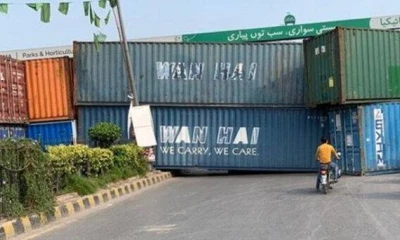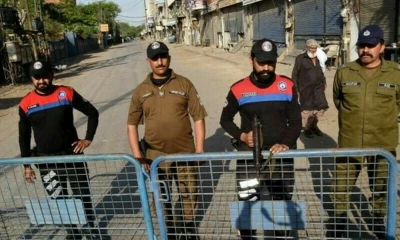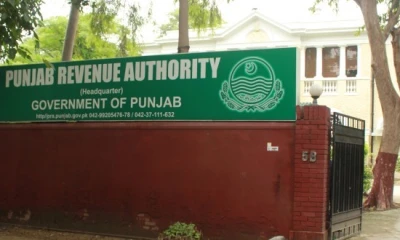Regional
Palestinians fear they’re being displaced permanently. Here’s why that’s logical.
In Israel, calls to expel Palestinians have become increasingly mainstream. Many Palestinians believe an expulsion, like the 1948 Nakba, is possible again.
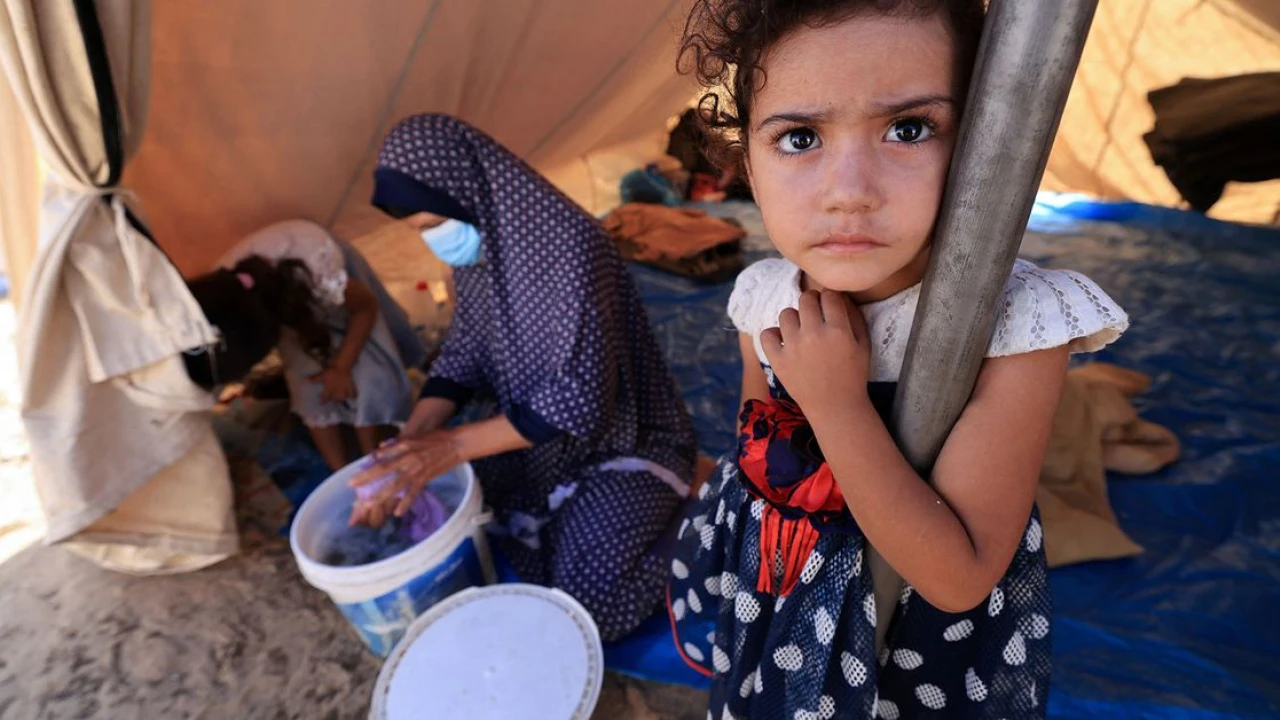
Since Hamas’s deadly attack on Israel on October 7, 1.4 million people have been displaced in Gaza following Israeli orders to flee south, according to the United Nations. That’s over 60 percent of the Gaza Strip’s population.
In wartime, civilians sometimes have to flee an area until it’s safe to return. In the early days following the Russian invasion in 2022, for instance, hundreds of thousands of Ukrainians fled in search of safety. But many Palestinians worldwide fear that those who are trying to escape the fighting in Gaza will never be able to return to their homes. The displacement, they worry, will become a permanent exile.
That helps explain why Palestinian Authority President Mahmoud Abbas, who governs the West Bank, is strongly opposing any plan that involves the mass displacement of Palestinians. Neighboring Arab states Egypt and Jordan are refusing to take in Gazans in part because of security and economic concerns, but also because they say they don’t want to enable such a displacement. “What is happening now in Gaza is an attempt to force civilian residents to take refuge and migrate to Egypt,” said Egyptian President Abdel Fattah al-Sisi, adding that such a displacement would render the idea of a Palestinian state unviable. “The land will be there, but the people won’t.”
There are three main drivers of this fear. The first is ingrained in Palestinian memory: In 1948, hundreds of thousands of Palestinians were permanently expelled during the first Arab-Israeli war, and intermittent displacements have continued ever since, as Israel has sought to maintain a Jewish majority in the state by pushing Palestinians out.
The second driver is what Israeli politicians were increasingly saying in the months before the Hamas attack — their pro-expulsionist rhetoric was so stark that experts warned signs of another mass expulsion were mounting.
And the third driver is what the Israeli defense establishment has been saying since October 7: calling to make Gaza smaller, if not permanently impossible for Palestinians to live in, let alone one day build a state in.
Understanding the historical context and what Israel wants today is key to understanding where this war will go tomorrow — and why Palestinians have every reason to fear that the people of Gaza will be displaced forever.
“I’m living the Nakba right now”
:no_upscale()/cdn.vox-cdn.com/uploads/chorus_asset/file/25036173/Vox_AP22180662925318.png)
:no_upscale()/cdn.vox-cdn.com/uploads/chorus_asset/file/25036174/Vox_AP23293827258337.png)
Most of the 2.1 million Palestinians in Gaza aren’t originally from Gaza. They’re the children or grandchildren of the more than 700,000 refugees who were expelled or forced to flee their homes in what is now Israel during the 1948 war that led to the country’s creation. This 75-year-old expulsion — which Palestinians call the Nakba, Arabic for “catastrophe” — is not a long-faded memory. It’s a deeply felt, visceral, and ongoing pain.
Many Palestinian families still have the keys to the houses they left in 1948. They took the keys with them because they were told by Israeli forces that they would be able to return home after a few weeks. That never happened; instead, they became permanent refugees. (Today, the Palestinian diaspora extends from Jordan, Lebanon, and Syria to the Gulf Arab countries and the West, while some Palestinians are citizens of Israel, making up roughly 20 percent of the country’s population.)
:no_upscale()/cdn.vox-cdn.com/uploads/chorus_asset/file/25036193/GettyImages_975328216.jpg)
These keys came to symbolize what Palestinians call “the right of return” — meaning the right of living refugees and their descendants to return to their original properties. Israel has refused to recognize such a right, fearing that letting in millions of refugees would be a demographic threat — turning the country’s Jewish majority into a minority and undermining the country’s status as a Jewish state.
Now, in a replay of 1948, some Palestinians in northern Gaza in recent weeks have fled their homes with their keys in hand. “I’m taking my house key and thinking, will I ever return to my home?” Arwa el-Rayes, a 56-year-old doctor, told the New York Times before leaving her childhood house in Gaza City.
While some in the media are already referring to this as a “second Nakba,” the Palestinians I spoke to said that’s a misnomer because it implies that the Nakba that began in 1948 ever ended.
:no_upscale()/cdn.vox-cdn.com/uploads/chorus_asset/file/25036339/GettyImages_1371380018.jpg)
“When people ask if I’m having flashbacks to the Nakba — no, I’m living the Nakba right now!” said Maysoon Zayid, a Palestinian American comedian, writer, and disability advocate. “It’s been an ongoing Nakba since 1948.”
Nadia Saah, a Brooklyn-based Palestinian rights activist and creator of Project48, an educational resource about the Nakba, agreed. “We’ve been carrying the generational trauma of our parents — and now, what our parents experienced, we’re watching unfold before our eyes on television,” she said. Saah’s mother fled to Jordan in 1948.
Dalia Hatuqa, a Palestinian American journalist currently based in the West Bank, told me her grandfather was killed and her father expelled from Rehaniya in present-day northern Israel — not in 1948, but in 1953, when the Israeli authorities suspected the villagers were getting too cozy with Lebanon, Israel’s adversary to the north. “That shows that the Nakba is something that’s ongoing. It’s something that never stopped. Because people are constantly being expelled.”
In 1967, long-simmering tensions in the region erupted into another war, fought between Israel and an Arab coalition made up of Jordan, Egypt, and Syria. Israel captured the West Bank (from Jordan), Gaza and the Sinai Peninsula (from Egypt), and the Golan Heights (from Syria). Roughly 300,000 Palestinians were displaced from the newly occupied territories, mostly to Jordan.
:no_upscale()/cdn.vox-cdn.com/uploads/chorus_asset/file/25036307/AP599697015290.jpg)
Ever since, increasing numbers of Israelis have moved into settlements in the West Bank; these new communities, subsidized by the government, serve the political purpose of creating new “facts on the ground” — a Jewish presence makes the land more likely to go to Israel, rather than Palestinians, in any potential future peace deal. And in the past few years, settlers have grown bolder about inflicting violence against Palestinians and driving them off their land, while Israeli authorities have ramped up demolitions of Palestinian homes under the pretext that they are just enforcing building regulations.
Even before the Israel-Hamas war, 2023 was already the deadliest year for Palestinians since 2005. Settler violence was on the rise. And the rhetoric and actions of Israel’s top brass with regard to Palestinian rights became so worrisome that experts warned another Nakba may be imminent.
What Israeli politicians were saying and doing in the months before the Hamas attack
This April, Peter Beinart, a Jewish American journalist who writes frequently about the Middle East, penned a story called “Could Israel carry out another Nakba?” in Jewish Currents magazine. He noted that as Israel’s government under Prime Minister Benjamin Netanyahu has lurched to the far right, the idea of expelling Palestinians has become increasingly mainstream in Israeli society. In a 2017 poll by the political scientist Khalil Shikaki, 40 percent of Israeli Jews said they believed Israeli Arabs and Palestinians in the West Bank “should be expelled or transferred.”
:no_upscale()/cdn.vox-cdn.com/uploads/chorus_asset/file/25036422/AP21026448512244.jpg)
By 2021, Israeli Finance Minister Bezalel Smotrich was telling Palestinian members of the Knesset, the Israeli legislature, that they were “here by mistake — because [Israel’s founder David] Ben-Gurion didn’t finish the job and throw you out in 1948.” (Former Israeli Defense Minister Benny Gantz, now a member of Israel’s war cabinet, recognized this for what it was, saying “Smotrich wants to cause another Palestinian Nakba — for him, escalation is a desirable thing.”) And by 2022, Israel’s national security minister, Itamar Ben-Gvir, felt emboldened enough to erect campaign billboards reading “May our enemies be banished” below photos of Knesset members from Palestinian parties.
While Smotrich and Ben-Gvir (both still in their positions in government) are known extremists, Beinart emphasized that expulsionist sentiment was also flourishing in Netanyahu’s center-right Likud party, with Israel’s current Defense Minister Yoav Gallant, National Security Adviser Tzachi Hanegbi, and Agriculture Minister Avi Dichter all alluding to removing Palestinians. Beinart wrote:
When Palestinians claim that Israel’s long term goal is not Palestinian statehood but Palestinian expulsion, they aren’t hallucinating … While the pace of Palestinian expulsion has waxed and waned in the 75 years since Israel’s war of independence, there is reason to worry that the radicalism of Israel’s current government, combined with rising violence in the West Bank, could turn the current trickle into a flood. Another Nakba is possible.
In a piece in the Nation this past August, Middle East historian Anne Irfan warned that “current conditions in Israel-Palestine show some alarming parallels with the run-up to 1948.” She noted that senior figures in Israel’s far-right government were openly calling for more Palestinian expulsions:
One of the worst attacks occurred in February, when around 400 settlers rampaged through the town of Huwara and neighboring villages in the northern West Bank. Setting Huwara ablaze, they left one civilian dead and 100 others injured, four critically. Crucially, this kind of settler violence is not detached from the Israeli state. The Huwara pogrom received open support from some cabinet ministers. Finance Minister Bezalel Smotrich, who also holds authority over civilian affairs in the West Bank, tweeted that Huwara should be “wiped out.” National Security Minister Itamar Ben-Gvir has similarly feted as “heroes” settlers who attack Palestinians.
All in all, Irfan judged the situation to be a powder keg. “All of this means that the risk of a second Nakba is at its highest in 75 years,” she wrote.
:no_upscale()/cdn.vox-cdn.com/uploads/chorus_asset/file/25036431/AP23298833108800.jpg)
Less than two months later, Hamas attacked Israel, killing 1,400 people and kidnapping over 200. And Israel declared war.
What the Israeli defense establishment has been saying since the Hamas attacks
Perhaps the most obvious reason Palestinians now fear a permanent displacement is that Israeli politicians have been ever more explicitly floating that possibility since Hamas’s attack, which was so astonishing and gruesome that it awakened intense shock, fear, and rage among the Israeli government, military, and public alike. Here are direct quotes from the Israeli defense establishment this month.
Ariel Kallner, a member of parliament from Netanyahu’s Likud party, wrote on X after the Hamas attack: “Right now, one goal: Nakba! A Nakba that will overshadow the Nakba of 48. Nakba in Gaza and Nakba to anyone who dares to join!” Revital Gotliv, another parliament member from the Likud party, wrote on X that the government should consider using nuclear weapons called Jericho missiles in Gaza. “Only an explosion that shakes the Middle East will restore this country’s dignity, strength and security! It’s time for a doomsday weapon. Shooting powerful missiles without limit. Not flattening a neighborhood. Crushing and flattening Gaza.” Giora Eiland, a reservist major general and former head of the Israeli National Security Council, wrote in a popular Hebrew-language newspaper, “The State of Israel has no choice but to turn Gaza into a place that is temporarily or permanently impossible to live in.” Elsewhere, he specified that “Israel needs to create a humanitarian crisis in Gaza, compelling tens of thousands or even hundreds of thousands to seek refuge in Egypt or the Gulf” and indeed that Israel must demand that “The entire population of Gaza will either move to Egypt or move to the Gulf.” Finally, he said that “Gaza will become a place where no human being can exist.” Minister of Foreign Affairs Eli Cohen alluded to partial annexation, per Israeli Army Radio. “At the end of this war, not only will Hamas no longer be in Gaza, the territory of Gaza will also decrease,” said Cohen. Similarly, Israeli minister Gideon Sa’ar said that “Gaza must be smaller by the end of the war,” specifying he meant “both in the east and in the north,” because losing land is “the price of loss that Arabs understand.” He added, “We must make the end of our campaign clear to everyone around us. Whoever starts a war against Israel must lose territory.” Herzi Halevi, the Israeli military chief of general staff, warned that after the Israeli military assault, “Gaza will not look the same.”These comments — coupled with dehumanizing rhetoric, like Israeli Defense Minister Yoav Gallant’s statement that “We are fighting human animals, and we are acting accordingly” — suggest that part of the Israeli defense establishment is not only interested in toppling Hamas (if so, there are better ways than what Israel is doing now); instead, these are explicit calls for permanent displacement and loss of land. So it’s not surprising that some Palestinians have come to believe Israel will take over at least part of the land in Gaza after the war.
They are not reassured by more recent comments by Gallant, who said that after the war with Hamas, Israel anticipates ending its “responsibility for life in the Gaza Strip,” such that even the tenuous ties between them — like allowing some Gazans into Israel to work or allowing some goods to enter Gaza — will be cut.
:no_upscale()/cdn.vox-cdn.com/uploads/chorus_asset/file/25036446/AP23298832958455.jpg)
There is such deep disagreement between the Israeli government and the military and such vociferous infighting within the government itself that it seems they lack a unified plan. (The US is reportedly worried about this, and Biden himself warned in a visit to Tel Aviv this month that Israel needs “clarity about the objectives.”) Some Israeli officials may be more narrowly interested in a legitimate military strategy to topple Hamas and defend Israeli citizens, while others further to the right may see in this war a chance to expel more Palestinians.
Experts have outlined a few possible long-term scenarios, all of them bad or unworkable: The Palestinian Authority takes control in the Gaza Strip (extremely difficult given its unpopularity), an international trusteeship governs Gaza with the UN as babysitter (highly unrealistic), new extremist groups spring up to fill a power vacuum (a security nightmare for Israel), or Israel ends up reoccupying Gaza.
Short of full reoccupation, which the Israeli ambassador to the US said Israel has “no desire” for, one possibility is for Israel to take part of Gaza’s land to widen the “no-go zone” or “buffer zone” that has existed for several years inside Gaza along the perimeter fence separating the enclave and Israel. (Nobody can live there currently, and Palestinians who come too close to the fence have been shot.)
This is what Zayid predicts: “Israel’s going to take that land and be like, ‘Buffer zone,’” she told me. There’s precedent for that: Israel has previously shrunk Gaza in this way when fighting flared up. In 2012, Harvard scholar Sara Roy noted that the buffer zone had absorbed “nearly 14 percent of Gaza’s total land and at least 48 percent of total arable land.”
Two Israeli ministers, Gideon Sa’ar and Avi Dichter, have explicitly stated that this is part of Israel’s plan. “On the Gaza Strip all along, we will have a margin,” Dichter said. “And they will not be able to get in. It will be a fire zone. And no matter who you are, you will never be able to come close to the Israeli border.” He added that the width of the buffer zone would have to be decided “according to the distance of the Israeli military or the Israeli settlements.”
Gaza is already one of the most densely populated, overcrowded places in the world. Palestinians fear that any loss of territory would make the enclave, which the UN has for years described as unlivable, even more so — unless vast numbers of people are killed or forced out.
:no_upscale()/cdn.vox-cdn.com/uploads/chorus_asset/file/25036428/AP23299390432609.jpg)
“The whole idea of the Nakba was to get rid of the people for the land. Killing people was a part of it, obviously, because how do you get people to flee?” Hatuqa, the journalist in the West Bank, said. “What I see now is that it’s ongoing. The idea here is to get rid of as many civilians as possible.”
“The Israelis want a game-changing situation and are openly speaking of mass displacement and making Gaza unlivable,” Saah told me. “We should take them at their word.”
Regardless of what ultimately happens to the territory, life will never be the same for many people in Gaza, where the death toll has already topped 7,000, according to Palestinian health officials.
An analysis of satellite imagery by the Economist suggests that Israeli airstrikes in Gaza have destroyed or damaged some 11,000 buildings — and counting. Per the analysis, “at least 92,000 people will have no home to return to when the fighting stops.” And that will be true no matter what happens next in the Israel-Hamas war.
:no_upscale()/cdn.vox-cdn.com/uploads/chorus_asset/file/25036328/GettyImages_1733386987.jpg)
For now, it’s unclear where Gaza’s refugees might go, whether temporarily or permanently. Egypt continues to refuse them entry, but some experts say it’s possible that the Arab nation, which is suffering an economic crisis, may be convinced to relent in exchange for financial incentives. That may save lives, but at the cost of displacement. It’s also possible that the international community, seeing the increasing devastation in Gaza, may be moved to accept refugees; Scotland has offered to be the first country in Europe to do so. US politicians are divided.
Ultimately, this chapter of the Palestinian Nakba may or may not beget the same kind of permanent mass expulsion as the chapter that unfolded 75 years ago. But dispossession can happen in other ways, from high death tolls to homelessness.
“I’m hoping that they don’t get pushed into Egypt,” Zayid said. “But these people are refugees now. Israel destroyed their homes. They have nothing to go back to.”
-

 Technology 2 days ago
Technology 2 days agoCrypto giant Bitcoin touches record high of $100,000
-

 Business 1 day ago
Business 1 day agoGold glitters again in Pakistan after global price hike
-

 World 2 days ago
World 2 days ago'Negligent act': Indian Navy submarine collides with fishing vessel
-

 Sports 22 hours ago
Sports 22 hours agoPakistan win toss, opt to field first against Zimbabwe in 1st ODI
-
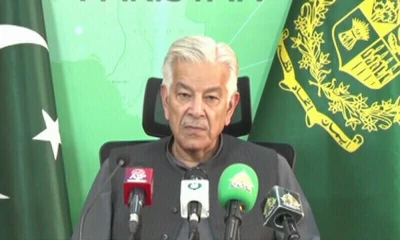
 Pakistan 2 days ago
Pakistan 2 days agoBushra Bibi's allegations against Saudi Arabia are shameful: Khawaja Asif
-

 Business 2 days ago
Business 2 days agoGold prices rise sharply in Pakistan
-
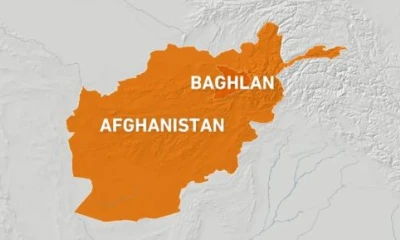
 World 2 days ago
World 2 days agoGuman kills 10 in attack on Sufi shrine in Afghanistan: interior ministry
-

 Pakistan 1 day ago
Pakistan 1 day agoGovt to suspend internet services amid PTI protest


